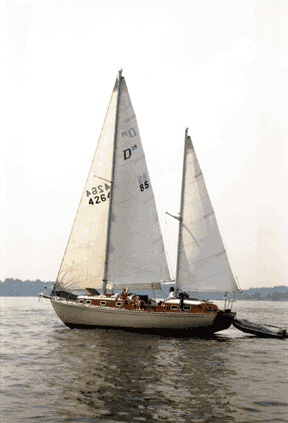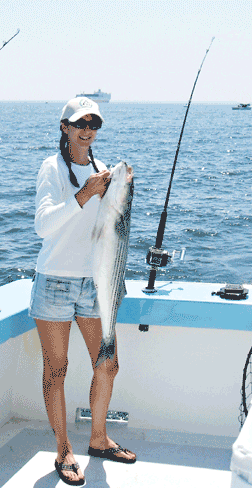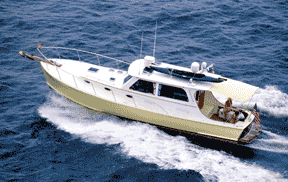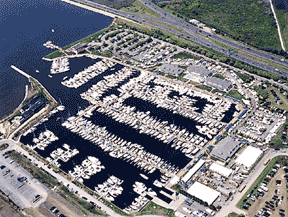 |
|||||||||||
|
|||||||||||
|
|||||||||||
|
Bay Fever There’s an itch to be scratched as boat fever and fish fever spreadby Sandra Olivetti MartinI must down to the seas again, to the lonely sea and the sky,And all I ask is a tall ship and a star to steer her by…– Sea-Fever, John Masefield, English Poet Laureate, 1930-1967It begins with an itch. Soon the symptoms diversify: unfocused stare, distraction, restlessness, heartache. For many residents of Chesapeake Country, the only cure for Bay fever is a boat. When it comes to what kind of boat, cures diverge. Fishing, sailing, cruising, speeding, weekending, paddling, yachting, windsurfing, styling, traveling, live-aboard, work-aboard. For every purpose on the water, there is a craft. This time of year, boats for all those purposes are returning to Bay waters. Scan the Bay on a day in March, and north and south all the way to the horizon you may see not a single boat. From January till the end of April, Bay traffic is light and specialized: Bay-builts for winter-working watermen, harvesting, for example, oysters; big freighters and container ships; work barges; frosty sailboats; kayaks seizing the day. Come the last week in April, the gap between sufferers of Bay fever and their cure is as big as the distance between their boat and the water. Wait: there goes one cure now, a big Grady White fishing boat on its trailer rushing back to the water. It’s happening everywhere, this great annual return to Chesapeake Bay of the fleet that accounts for much of pleasure boating’s $2.4 billion boost to Maryland’s economy. I must down to the seas again, for the call of the running tide
|
|||||||||||
 |
A locally built dreamboat, opposite, the Thomas Point 43, is made by boatwright Joe Reed at Mast & Mallet Boatworks in Edgewater.Whatever the boat, odds are good you can find it at the Bay Bridge Boat Show, left.Despite the many sails and riggings dotting the horizon in Chesapeake Country, only 13,000 registered sailboats are in Maryland. |
Now all that shrink-wrap is coming off, piling up in billows and challenging the marine trades industry with finding new ways of recycling.
Shrink-wrapping is one of some 27,500 marine jobs supported by boating. This time of year, all of them are in demand as boat yards buzz like beehives.
Any day the weather is tolerable, do-it-yourself owners — like Capt. Paul O’Conner of the charter boat Bay Hog, who worked through March and early April on the hard at Gates Marina in Deale — park by their boats and go to work, scrubbing, scraping, polishing, repairing. Visit a marina or yacht yard, and you’ll see plenty of D.C. and Virginia license plates as absentee owners drive down to the water to scratch their case of Bay fever with a few hours of work on boats small or large.
Boats are notoriously fussy, and anyone visited by a mechanic will have a long list of repairs to be made, along with dewinterizing.
Bottoms must be painted, but first comes the laborious job of scraping, power washing or sand- (and, nowadays, baking soda) blasting. It’s a tougher job still now that we’re thinking about how our messes spoil the environment, for it’s got to be done undercover — at least in Green Marinas, which are encouraged and certified by the state.
Then comes the bottom paint, a toxic, anti-fouling coating that can cost more than $100 a gallon. With so much toxic work to do, careful workers dress up in suits and ventilating masks.
Finally, a boat needs washing and polishing.
Now the weeks of labor in the driveway or at the boatyard are paying off. The weather is finally warming.
Now only days — maybe even hours — stand between all those boats and the big splash.
And all I ask is a windy day with the white clouds flying,
And the flung spray and the blown spume, and the sea-gulls crying.
Last week was the big launch of the first fleet of spring. Striped bass fishing season opened April 21, and that regulated and highly anticipated event is the Easter of Bay fishers. It is their resurrection.
It’s so big that even Gov. Martin O’Malley hailed it.
“The weather forecast for opening day and the following week is nearly perfect,” O’Malley said in a press release. “That, coupled with the robust numbers of large rockfish currently in the Chesapeake, should make conditions ideal for anglers and their families to enjoy a day on the Bay.”
• • •
Through April, Maryland’s 400-boat charter fishing fleet returned to the water in preparation for the big day.
“The last week, I’ve been putting in 18-hour days,” said Glenn James on Opening Day Eve. Past president of the Maryland Charterboat Association, James captains the 55-foot Bounty Hunter, the largest charterboat on the Bay, out of Rod ’n’ Reel in Chesapeake Beach.
“On our boat,” James continues, “we pick a project every year. This was the year to redo the interior — remodeling, paint, carpet, sinks, countertops — and like most boat projects, it grew.”
With over 100 charter boats, Calvert ports more than any other county in Maryland, with the big ports at Chesapeake Beach and Solomons and a smaller concentration at Breezy Point. Anne Arundel County is home to more than 70 charters, with a handful in Annapolis, a few as far north as Pasadena, others in South County and a big fleet at Happy Harbor in Deale.
At all those marinas and piers, captains and mates have lately been scratching a near-intolerable itch by polishing and primping their boats.
Sportsfishermen who fish on their own are just as avid.
A few, like Bay Weekly columnist Dennis Doyle and his charter captain buddy Frank Tuma, of Down Time out of Breezy Point, practiced by hooking rockfish that must be released (Vol. xv, No. 16: April 19).
But the Big Day was April 21, when the Trophy Rockfish season opened.
“The whole charter fleet was out, along with the whole recreational fleet. It was boats as far as you could see; you could not turn around,” said the Waterman’s Association’s Larry Simns of the season’s opening.
That day let long-fasting Maryland anglers loose on mammoth fish that have returned from ocean life to spawn in the Bay. Rockfish responded to their own Bay fever much earlier in the year; the late opening and ban on rockfishing in tributaries leaves most fish undisturbed until after they’ve spawned.
“It’s going to be good,” said James on the eve of the season’s opening. “There are plenty of fish out there.”
In fact, James and Simns agree that catching so far is hard work with April’s earlier cold, wet weather slowing the movement of big fish out of the tributaries into the Bay.
Regardless of how well nature provides, this year’s catch must be only half of last year’s.
Over the past two years, the fishing was way too good. Protecting the precious species — on which Maryland’s commercial and recreational fisheries depend — is a region-wide obligation, shouldered by the Atlantic States Marine Fisheries Commission. Maryland exceeded its quota in 2005 and 2006. This year’s trophy season is limited to 30,000 — half of last year’s big fish quota of 60,000 — and about the number fish overcaught in Maryland in both ’06 and ’05.
From April 21 to May 15, the big-fish season, each angler is allowed to keep one legal fish per day. Legal fish measure 28 to 35 inches and 41 inches or more. Fish under 28 inches and between 35 and 41 inches must be released promptly.
Fifty thousand of Maryland’s 165,000 registered powerboats are licensed for fishing. Even the National Marine Manufacturers Association can’t say how many companies make fishing boats, but they range from john boats to, for example, a $440,000 36-foot Grady White Express, the boat Tristate Marine salesman Robert Warren calls the “Mercedes Benz that floats in the water.”
The fish are back, and all the owners of those boats have bad cases of Bay fever.
 |
The annual return to Chesapeake Bay of the fishing fleet accounts for much of pleasure boating’s $2.4 billion boost to Maryland’s economy. |
I must down to the seas again, to the vagrant gypsy life,
To the gull’s way and the whale’s way where the wind’s like a whetted knife;
The power fleet now returning to the water satisfies more kinds of fever than fish. Whether your fever burns for inflatables, personal watercraft, ski and wake-board inboards, cruisers, jet boats, pontoon boats, motor yachts or houseboats — you can likely find its cure at the Bay Bridge Boat Show, from April 26 to 28.
Five hundred boats from 132 manufacturers surround Stevensville’s Bay Bridge Marina by land and water at this spring cousin to October’s famous U.S. Sail and Power Boat Shows. About half the boats are new, and about half brokerage boats on second or third sale. Buy any of them, and you can get your boat in the water by May.
Boats range from the 20-foot Jet Dock to the 70-foot Marquis 65. Among industry standards like Sea Ray and Silverton, Bayliner and Boston Whaler are custom crafts like boatwright Joe Reed’s Thomas Point 40, built at Mast and Mallet in Edgewater. Few are sailboats.
Among them may be your dreamboat, the Chesapeake Classic Hooper Island Draketail; a Nordic tug that looks like it cruised out of a kids’ book; a downeast Albin, Back Cove, Legacy or Sabre; a high-style European ApreMare; an elegantly pricey Hinckley; a rough and ready Boston Whaler.
Annapolis calls itself America’s Sailing Capital, so the big surprise in boat registrations as reported to the U.S. Coast Guard by the Maryland Department of Natural Resources is the disparity between sail and powerboats — at least statewide. Sailboats number only about 13,000 with powerboats more than 12 times more numerous — not counting about 19,000 personal watercraft.
You wouldn’t think so looking at white sails specking the Bay on a breezy day or counting the masts that tower over marinas. At two of Chesapeake Country’s biggest marinas, Herrington Harbour North in Tracys Landing and South in Rose Haven, sailboats dominate, about 60 to 40 percent, according to marina manager Hamilton Chaney.
Visit the yards of those marinas now, as boats return to the water — or cruise their docks in a month or so — and you’ll see the diversity of the Bay’s fleet under sail. Here and nationally, Beneteau, Hunter and Catalina are the popular leaders, but every second or third boat offers an exceptional eyeful.
To see the variety of boats under sail all in one place, however, you’ll have to wait until the first week in October, when the U.S. Sailboat Show returns to Annapolis, from the 4th thru the 8th, for the 38th year, bringing 250 sail boats to town.
“Any boat currently marketed by a foreign or domestic manufacturer in representation in U.S. is in the Annapolis Boat Show. It has to be,” says show general manager Jim Barthold. “The Annapolis show is the mecca for sailboat enthusiasts. It’s the one show you have to go to if you’re serious about looking for new boats and before you make a buying decision. You haven’t finished the process until you see what else is there, and the only place is Annapolis.”
If you haven’t caught Bay fever yet, boat shows are the place it’s most contagious. If you’ve already caught the fever, a boat show’s where you’re likely to cure it.
And all I ask is a merry yarn from a laughing fellow-rover
And quiet sleep and a sweet dream when the long trick’s over.
Or you might find, as my captain and I have, that your fever takes a cure that’s not on even these well-stocked shelves.
It’s not that he and I are seeking two different boats. Our problem, as we search for our third powerboat, is that our combined tastes have diverged from production manufacturing.
Earlier boats were love at first sight. Back in 1985, when we bought our first, we’d just moved to the Bay. Like the guy who’s fallen off the turnip truck, Capt. Bill bought the first boat he saw.
Looking back, it wasn’t his fault; it was entrapment. First, he was a landlocked Midwesterner and a devout fisherman born under the water sign of Cancer. Second, the seller hailed from the town where we’d lived the last decade, Springfield, Illinois. Finally, on his first trip out, Bill caught a huge bluefish. The boat lived long enough to disprove its name, Reliable Source, and to persuade us that the seller had help from lesser fish gods in hooking Bill up with that fish.
Our second, a neat little Sea Ray, hooked us just about as easily and served us as well as any boat can for a decade. We’d been admiring its ilk for ages before we acted, which is easy. Not only are Sea Rays good looking, they’re everywhere — 40 models in sizes from 18 to 68 feet.
This particular year and model, a 1989 Sundancer, is fishable, funable, livable and big for its small size. In 23 feet, it’s got V-berth and mid-berth, head and galley, two showers and nearly ample stowage. So when we contracted a new case of boat fever, we started looking at Sea Rays at boat shows and at Clark’s Sea Ray dealerships nearby, one in Shady Side and one in Stevensville.
What we found was that Sea Rays — and all the boats of that class, Cris Craft, Bayliner, Magnum — had changed starting in the 1990s.
Chaney of Herrington Harbour says boats are growing “longer, wider and more sophisticated, just like houses and cars. They’re more technologically advanced, and owners require more: power, phone, all the services right at the slip.”
They’re slicker, as well. Sleek on the outside as high-end athletic shoes; sleek on the inside as floating plastic palaces. At under 30 feet, there’s no place to put much of anything, and you sure wouldn’t bring fishing poles stained with blood and guts into a cabin upholstered in puffy white satin. Even Sea Ray’s Amberjack, its fishing boat, couldn’t bridge the gap back to where we wanted to be.
So we’ve been haunting boat shows. By car and boat, we sightsee through boatyards and docks. We read Soundings avidly. We scour the Internet. We regularly find the right boat — Sabres, Back Coves, Legacys — at the wrong price.
 |
Will this Albin 28 cure the writer’s case of Bay fever? |
And the wheel’s kick and the wind’s song and the white sail’s shaking,
And a grey mist on the sea’s face, and a grey dawn breaking.
“When we listed it last fall, it sat,” said boat broker Rob Begor. “Now it’s spring, and people are calling. You’re the second one this week.”
I was falling in love, so the news of a rival fanned my ardor for the boat we were touring. Unexpectedly, this Albin 28 Tournament Express was looking more and more like my dreamboat. From obstruction, the raised engine box amidships had become an attraction, both a seat and a support for a custom-crafted picnic table. Until the picnic called the table forth, it folded cleverly up against the starboard hull, under cover. On port, three fishing rods would rack, horizontally. Aft were so many built-in fish boxes that some could be converted to storage.
But this was no single-minded fishing boat. It was one of a rare breed, customized right where I was seeing it, at Oxford Yacht Yard. This downeast boat, made in Rhode Island, had a local history, a quality I crave as much as stowage. For, following the advice of Soundings’ How to Buy a New or Used Boat, I’ve converted my boating requirements into a mantra:
When I’m not at work in boating weather, I want to be on my boat. So it needs to be home and office as well as fishing boat, cruiser, picnic and pleasure boat. It needs to look like a boat, not a bordello, and it needs to wash down well and clean up easy. All that plus diesel, GPS, a chart table, screens and well-railed sides I can walk around to the bow.
Be still my beating heart.
Yes, Bay fever feels a lot like love.
|
Current Issue \\ Archives \\ Subscriptions \\ Clasified Advertising \\ Display Advertising |
© COPYRIGHT 2007 by New Bay Enterprises, Inc. All rights reserved.


